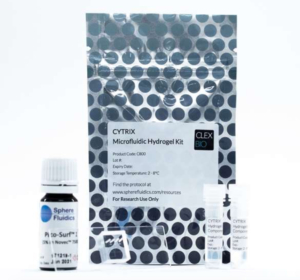Sphere Fluidics and ClexBio introduce CYTRIX Microfluidic Hydrogel Kit
Sphere Fluidics, a company commercializing single cell analysis systems underpinned by its patented picodroplet technology, and ClexBio, a pioneer in solutions for tissue engineering and single-cell techniques, have launched the biocompatible CYTRIX Microfluidic Hydrogel Kit. The kit combines ClexBio’s novel CYTRIX Hydrogel with Sphere Fluidics’ specially designed Pico-Gen™ double aqueous biochip to allow the plug-and-play generation of defined, reproducible and tailorable hydrogel microstructures for 3D cell culture, organoids, single-cell analysis, and many other applications. This allows researchers to study valuable cells over many weeks rather than days in defined microenvironments that mimic the natural extracellular matrix.
The CYTRIX Hydrogel overcomes the challenges of existing microfluidic hydrogel formation techniques, such as clogging, finicky temperature control or time-critical mixing procedures. It offers cytocompatibility and microfluidic-optimized gelation kinetics, providing researchers with a cell-friendly solution to reduce the effect of harmful temperatures, pH changes and use of UV-light required for existing hydrogel formation techniques. Paired with the Sphere Fluidics Pico-Gen double aqueous biochip and microfluidics, the CYTRIX Hydrogel enables efficient encapsulation of mammalian cells, bacteria, and other microorganisms in a homogeneous and defined extracellular matrix that supports cell viability.
Dr. Xin Li, Associate Director of Science at Sphere Fluidics said: “The CYTRIX Microfluidic Hydrogel Kit mimics the 3D microenvironment and help researchers explore the potential of hydrogel-based microfluidics in tissue engineering, drug discovery and regenerative medicine over many weeks.”
Dr. Armend Håti, CEO and Co-Founder of ClexBio said: “This exciting collaboration with Sphere Fluidics has enabled us to deliver one of the first commercial solutions that allows simple and cell-friendly formation of cell-laden microgels, lengthening the time that researchers can study the contents of microspheres.”
- For further information, visit: https://spherefluidics.com/microfluidic-hydrogel




